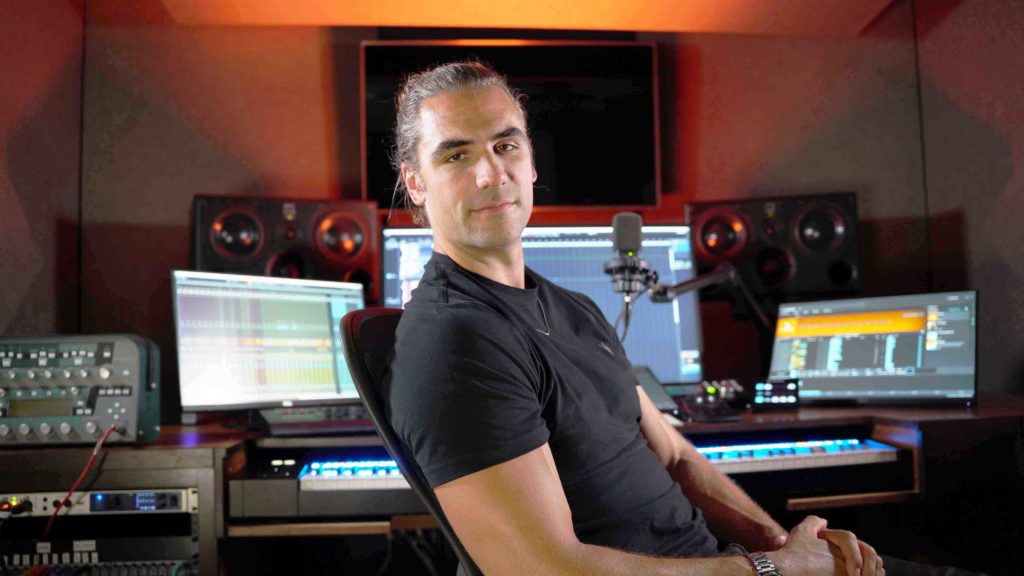Course content
Welcome to Cinematic Scoring with Daniel Stockdale, where you will learn the essential elements of the scoring process. In this first lesson, Dan lays a roadmap of key parameters for both the visuals and music in the cinematic scoring process. This is an essential element of creating a good score and sets the foundation for the rest of the masterclass. Dan discusses important elements to consider when beginning a score, including tempo marking, hits/accent spots, and much more. Essential for producers who want to understand how to better structure their tracks.
Starting from scratch can pose challenges in the world of scoring. As such, Daniel outlines his methods for creating a scoring template. He goes in-depth into his own template as well as key plug-ins to use and software that aids in the workflow of scoring. This tutorial can help producers of any DAW create an efficient means of starting off any scoring work.
In this first part, Daniel goes over how to map out string and percussion arrangements. Utilizing very simplistic plug-ins and sounds along with a very few amount of tracks, Dan shows how an overall framework for the score can be created and fleshed out later down the line into the full score. This tutorial can greatly help producers looking to speed up their workflow and arrangement capabilities.
In this second part, Daniel covers his favorite choices for Kontakt and software instruments when going about the initial sketching ideas. He delves into all the different Kontakt instruments producers in the industry turn to and discusses not only their use cases, but also ways in which producers can tailor them to their own music cinematic or not. This is a great tutorial for producers wanting to learn more about software instrument libraries such as Kontakt and how to implement these within their workflow.
So far the tutorial series has focused on MIDI instrumentation, but in this tutorial Daniel discusses how to mix in audio samples for enhanced production capabilities. He shows different examples of how audio can be used to amplify the effect of certain midi instruments and can stand alone as key pieces of a score. This tutorial can help producers of any DAW discover new techniques in regards to audio samples that they can implement in their own music.
Daniel discusses how to take the skeleton work of sketches and buff them up into full productions of scores starting with the string section in this video. He shows a number of different techniques to take the one instrument-based string sketch and spread that out across different sound palettes and instruments. This tutorial can be of great use to producers looking to add more complexity and depth to their productions.
In this tutorial, Daniel shows how he maps midi parameters and uses a controller to achieve a more realistic instrumentation sound. Midi controllers allow for more precision and control over key facets of the software instrument, so producers looking for more of an authentic sound and feel to their music will find great use in this video.
Daniel discusses how to take sketches and develop them into full productions with the brass section in this video. He shows a whole host of different midi techniques and instrumentation concepts for producers to harness the full power of the brass section in scoring. This tutorial can be of great use to producers looking to add more complexity and knowledge of brass instruments in their arsenal of sounds.
In addition to the strings and brass sections, Daniel shows how to take the percussion map and build it out into a full percussion production. He discusses ways to intertwine different percussion instrumentation with one another and how to make them fit together with the existing instruments such as strings and brass that have been sketched out. This tutorial is perfect for producers looking to diversify and expand their percussion game.
Daniel uncovers how to utilize modern day sound design with popular synths to bring added flair to scores. Dan shows commonly used synth sounds and how they are used both individually and layered with instrumentation to bring out more life within productions. This tutorial is great for producers of any style and genre looking to add ideas for new sound design methods in their own productions.
Moving on from solely instruments, Daniel takes a look at how producers can use the human voice in their scores. He shows his choice of Kontakt instruments for choir sounds and where they can fit best within scores. This tutorial can help producers wanting to bring more human feels to their music with the inclusion of the human voice.
Daniel dives into the different methods he uses in working with different file types for scoring. Working with a multitude of media files can pose challenges for producers and Dan unearths key software and strategies producers of all DAWs can utilize to maximize efficiency and save CPU when scoring.
In this tutorial, Daniel discusses what deliverables need to commonly be ready for producers to send in when composing music for film. He shows his method of stemming for delivering work to other producers/engineers and the importance of keeping a solidified system for these means.
In this tutorial, Daniel discusses how he uses percussive hits to make his production more impactful for the listener. Utilizing different styles of layering percussion and hits of different magnitudes, Daniel shows how cinematic hits can be employed to achieve various tones and textures. Producers of all styles can use the techniques discussed to add more dramatic movement within their songs.
In the first part of this tutorial, Daniel covers his methods for creating and layering percussive cinematic sounds. Through the techniques explained in this video, Daniel discusses the different tonal elements of his go to cinematic sounds and how to create a sense of action and momentum within the music. The tips expressed in this video can help producers of all DAWS and genres provide a more dynamic and epic spin on their production.
In the second part of this tutorial, Daniel goes over the brass and strings techniques he employs to amplify his cinematic production. Utilizing melodic instruments commonly incorporated in an orchestral setting adds to the overall cinematic experience of the music. The methods Daniel explains in this video helps add onto the percussive drive of the production covered in the previous video creating a more dimensional sound.

Welcome to Cinematic Scoring with Daniel Stockdale, where you will learn the essential elements of the scoring process. In this first lesson, Dan lays a roadmap of key parameters for both the visuals and music in the cinematic scoring process. This is an essential element of creating a good score and sets the foundation for the rest of the masterclass. Dan discusses important elements to consider when beginning a score, including tempo marking, hits/accent spots, and much more. Essential for producers who want to understand how to better structure their tracks.
